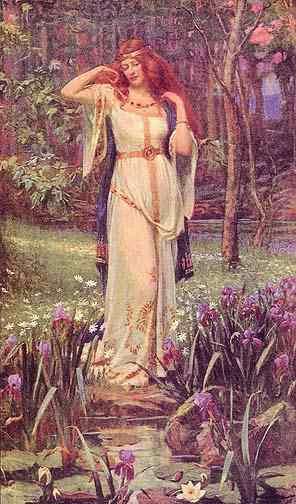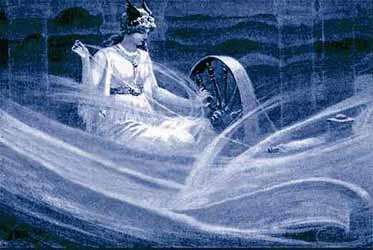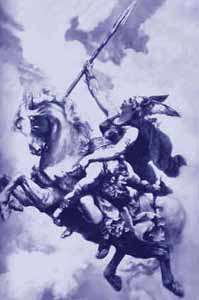Frige-daeg, Friday, is further equated with dies veneris, the day of Venus, the love-goddess so revered by the Romans.
Frigg was the direct daughter of Fjorgyn, the Goddess of Earth. She kept her own hall, called Fensalir. She was wife to Odin, All-Father, and is herself an All-Mother.
Women prayed to her for children and prayed again for safe labour and delivery.
Frigg gave birth to the perfectly good and beautiful Baldr, and tried to protect her son from death itself by requesting a pledge from every thing in the world not to harm him. She neglected however to ask the mistletoe, and it was with a small dart of this symbol of Winter resurrection that Baldr was felled. She is thus the Sorrowing Mother as well as the lusty bed companion. But when Frigg wept, her tears were of pure gold.
FREYA – BELOVED OF WARRIORS

Goddess of sex, battle, and pleasure, most beautiful and desirable of white-armed women, Freyja was sister to the male fertility god Freyr. Freyja had unusual parity with Odin, for they divided the heroic dead amongst themselves. Half went to live eternally in Odin’s hall, and half in Freyja’s hall Sessrumnir- and the goddess got first pick.
As befits a goddess, Freyja owned potent magical equipment. Like Frigg, she possessed a falcon skin, which when pulled over her shoulders, allowed her to take the form of that raptor.This also provided a useful disguise when needed – important to a goddess whose personage made her instantly recognisable.
Freyja’s most wonderful adornment was her necklace (or possibly a jewelled belt), Brisingamen.It was crafted by four dwarfs, and was of exceptional beauty.Freyja so longed for it that she consented to spend one night each in the arms of its makers as her payment.This was a just recompense in the eyes of the goddess, for as the necklace was the finest of all things the dwarfs could produce, the utter summation of their skill, why not repay them with an equally precious example of her love-art?
Freyja always wished to give her love freely.Her beauty and desirability often attracted the attention of those she did not want, such as the giant who offered to build an impregnable defensive wall around Asgard, the dwelling of the gods, in exchange for taking Freyja away as his wife. The goddess knew nothing of this agreement, and her outraged indignation at being so wagered grew the greater as the wall grew taller. Never believing they would have to forfeit Freyja, the gods grew more and more uneasy in their wager, until Loki ,who had urged the agreement, was forced to utilise his trickster ability to the fullest.
Three animals are associated with Freyja. She is pulled about in a cart to which two cats are harnessed. Their sinuous beauty and comfort-loving nature recall one side of the goddess. The other two animals are direct symbols of sexuality and strength. Her golden-bristled boar is called Battle Swine (Hildisvini), and recalls her role as the receiver of heroic dead. Battle helmets topped with iron and bronze images of boars have been found throughout England and Scandinavia, for the boar’s savage and cunning nature was widely revered. The other animal is the mare, associated with night, unbridled sexuality, and dangerous magical power. To “ride the night-mare” meant then, as now, to have bad dreams.
SIF – THE GOLDEN HAIRED
Of the lovely Sif, little is known. Her abundant yellow hair suggests she was a fertility goddess, her hair representing ripe grain. She was the wife of Thor, most popular of all gods. As his chosen beloved she may have been the consummate form of the ideal woman for the common man.
Sif had exceptionally beautiful long hair, which her husband treasured. One morning upon awaking she discovered to her horror that the spiteful Loki had shorn it all off during the night. The bald and mortified goddess appealed to Thor, who sought Loki out and started the trickster god on a search to repair his mischief. Only drawfs possessed the skill required to replace hair so lovely.

They spun fibres of dazzling sheen and baby-soft fineness, and Loki carried lengths of it back to the despondent Sif. When she held the fibres to her scalp, they took root and grew live upon her head, and once again Sif possessed magnificent hair, for the drawfs had spun it from the finest gold.
VALKYRIE

The Valkyrie is, in the oldest strata of belief, a corpse goddess, represented by the carrion-eating raven. The name in Old Norse, valkyrja, as well as Old English w lcyrge means literally, “chooser of the slain.” The word for valkyrie was used by Anglo-Saxon scholars to gloss the names of the Greco-Roman goddeses of vengeance and retribution, the Furies or Erinyes, as well as for the Roman goddess of war, Bellona.
The Valkyrie is related to the Celtic warrior-goddess, the Morrigan, who likewise may assume the form of the raven. The Irish badb is at one and the same time a seeress foretelling the fate of men upon the battlefield and is also the carrion-crow or raven. (Rooth 228). At times the female seeress was replaced by the work of women’s hands in the form of a Raven banner …woven of the cleanest and whitest silk and no picture of any figure was found upon it. In case of war, however, a raven was always to be seen upon it, as if woven into it. If the Danes were going to win the battle, the raven appeared, beak wide open, flapping its wings and restless on its feet. If they were going to be defeated, the raven did not stir at all, and its limbs hung motionless.
NEWS ARTICLES
The Amazing Vikings
May 8, 2000 – Time Magazine
They earned their brutal reputation–but the Norse were also craftsmen, explorers and believers in democracy.
Ravagers, despoilers, pagans, heathens–such epithets pretty well summed up the Vikings for those who lived in the British Isles during medieval times. For hundreds of years after their bloody appearance at the end of the 8th century A.D., these ruthless raiders would periodically sweep in from the sea to kill, plunder and destroy, essentially at will.